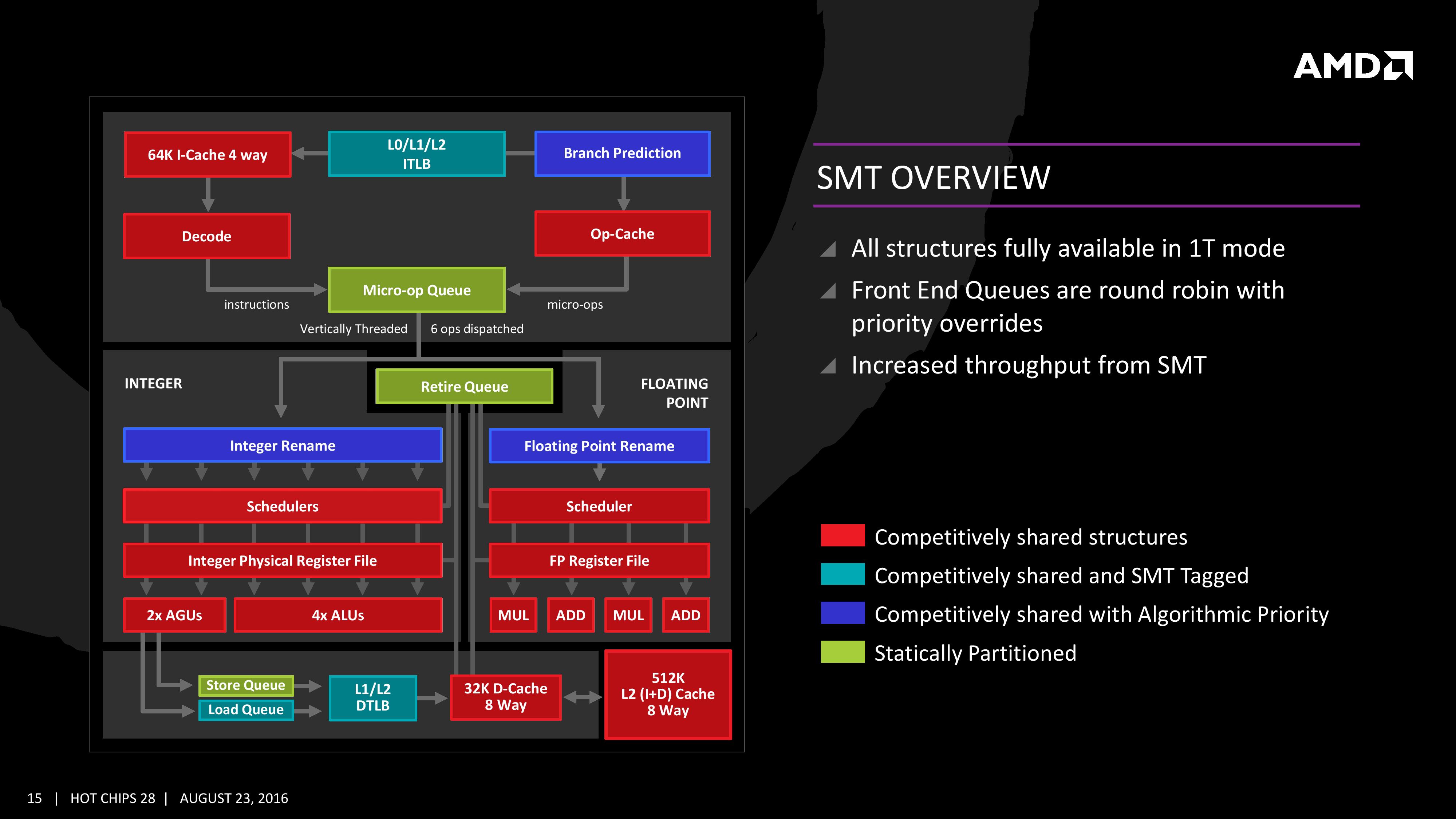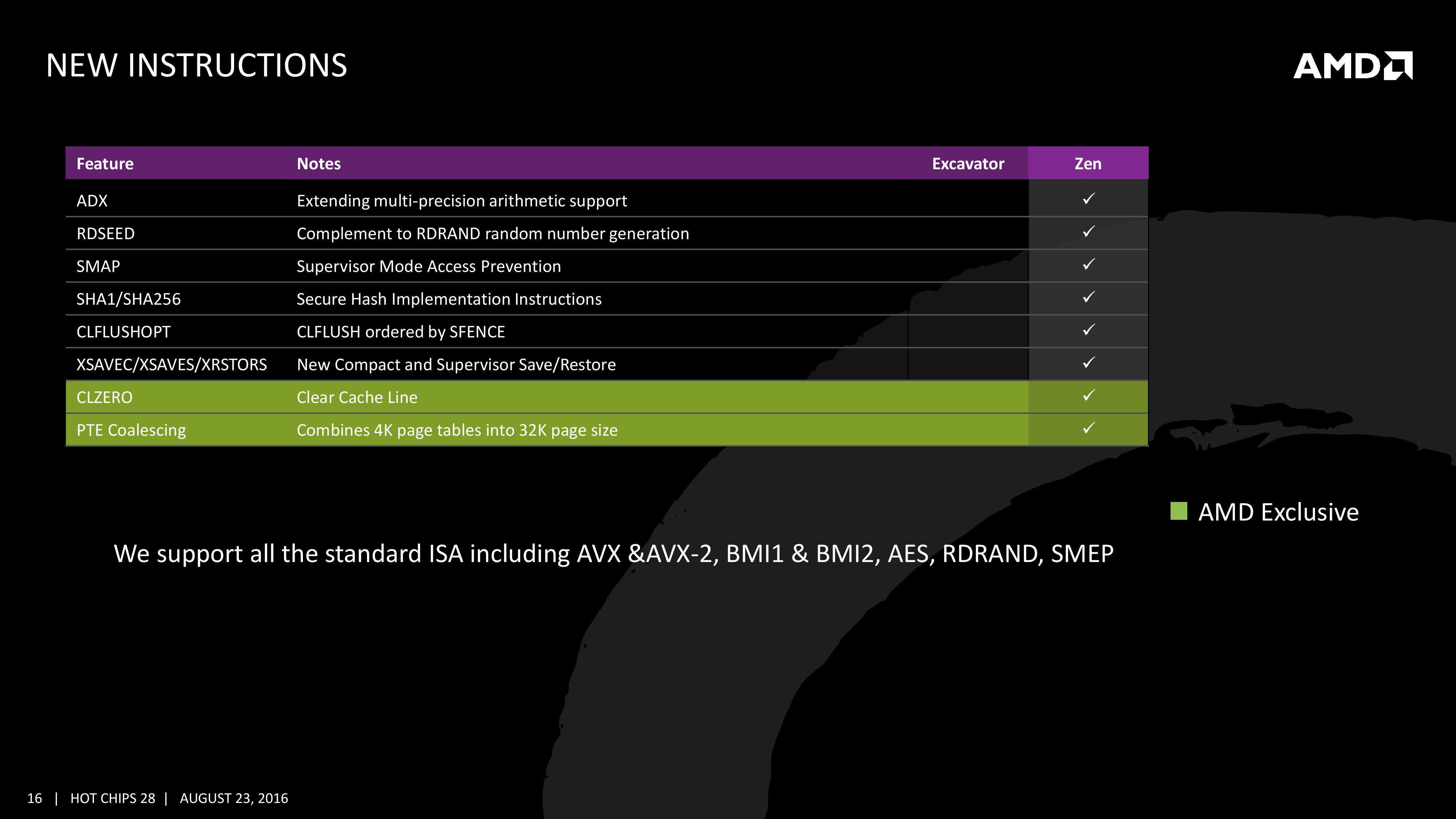AMD Zen Microarchiture Part 2: Extracting Instruction-Level Parallelism
by Ian Cutress on August 23, 2016 8:45 PM EST- Posted in
- CPUs
- AMD
- x86
- Zen
- Microarchitecture
Simultaneous MultiThreading (SMT)
Zen will be AMD’s first foray into a true simultaneous multithreading structure, and certain parts of the core will act differently depending on their implementation. There are many ways to manage threads, particularly to avoid stalls where one thread is blocking another that ends in the system hanging or crashing. The drivers that communicate with the OS also have to make sure they can distinguish between threads running on new cores or when a core is already occupied – to achieve maximum throughput then four threads should be across two cores, but for efficiency where speed isn’t a factor, perhaps power gating/clock gating half the cores in a CCX is a good idea.
There are a number of ways that AMD will deal with thread management. The basic way is time slicing, and giving each thread an equal share of the pie. This is not always the best policy, especially when you have one performance dominant thread, or one thread that creates a lot of stalls, or a thread where latency is vital. In some methodologies the importance of a thread can be tagged or determined, and this is what we get here, though for some of the structures in the core it has to revert to a basic model.
With each thread, AMD performs internal analysis on the data stream for each to see which thread has algorithmic priority. This means that certain threads will require more resources, or that a branch miss needs to be prioritized to avoid long stall delays. The elements in blue (Branch Prediction, INT/FP Rename) operate on this methodology.
A thread can also be tagged with higher priority. This is important for latency sensitive operations, such as a touch-screen input or immediate user input elements required. The Translation Lookaside Buffers work in this way, to prioritize looking for recent virtual memory address translations. The Load Queue is similarly enabled this way, as typically low latency workloads require data as soon as possible, so the load queue is perfect for this.
Certain parts of the core are statically partitioned, giving each thread an equal timing. This is implemented mostly for anything that is typically processed in-order, such as anything coming out of the micro-op queue, the retire queue and the store queue.
The rest of the core is competitive, meaning that if a thread demands more resources it will try to get there first if there is space to do so each cycle.
New Instructions
AMD has a couple of tricks up its sleeve for Zen. Along with including the standard ISA, there are a few new custom instructions that are AMD only.
Some of the new commands are linked with ones that Intel already uses, such as RDSEED for random number generation, or SHA1/SHA256 for cryptography. The two new instructions are CLZERO and PTE Coalescing.
The first, CLZERO, is aimed to clear a cache line and is more aimed at the data center and HPC crowds. This allows a thread to clear a poisoned cache line atomically (in one cycle) in preparation for zero data structures. It also allows a level of repeatability when the cache line is filled with expected data. CLZERO support will be determined by a CPUID bit.
PTE (Page Table Entry) Coalescing is the ability to combine small 4K page tables into 32K page tables, and is a software transparent implementation. This is useful for reducing the number of entries in the TLBs and the queues, but requires certain criteria of the data to be used within the branch predictor to be met.












106 Comments
View All Comments
atlantico - Friday, August 26, 2016 - link
Wow looncraz!! Really cool effort you made :)Spunjji - Saturday, August 27, 2016 - link
You numbers are different to everyone else's. Given that you don't cite any of your sources I believe everyone else.Krysto - Wednesday, August 24, 2016 - link
I would hope they try to double the cores of Intel for notebooks.Dual-core Zen without SMT will DESTROY Intel's Atom-based Celerons and Pentiums at the low-end. There will be absolutely ZERO reason to get a Celeron or Pentium notebooks once Zen appears on the market at that price range.
But at the Core i3 and Core i5 levels, I was hoping AMD would price a quad-core Zen with no SMT against dual-core Core i3 and Core i5, and a quad-core Zen with SMT against Intel's quad-core (no HT) Core i5, and finally 8-core with and without SMT variants against Intel's quad-core Core i7 chips (with HT).
If they can basically double the cores compared to what Intel has to offer at around the same price level, and maybe with only slightly worse single-thread performance and slightly worse power consumption, AMD's chips should be a NO-BRAINER. The value would be incredible, and it would push the market towards having powerful quad-core chips by default for most PCs. Intel is going to HATE that, because it would seriously cut into their profits. So AMD could use that strategy to both offer great value products and hurt Intel significantly.
looncraz - Wednesday, August 24, 2016 - link
AMD is not seeking the low end, they are trying to redefine AMD as the top-tier CPU company they once were. They are aiming for the top and the bulk of the market.Zen+'s 15% IPC improvement over Zen might just give them the performance crown, but I'm sure Intel has taken note and planned accordingly.
zaza - Wednesday, August 24, 2016 - link
but the AMD CCX module is a quad core module. i am not sure if it is easy for AMD to just remove two.looncraz - Wednesday, August 24, 2016 - link
Very easy, you just fuse off the defective core, that's the beauty of independent cores. The core complex just shares a common data bus and third level cache. Disabling a core in the complex will simply have it not ask for data on the common data bus. The L3 cache may or may not be cut down (probably will be).H2323 - Wednesday, August 24, 2016 - link
"While Zen is initially a high-performance x86 core at heart, it is designed to scale all the way from notebooks to supercomputers, or from where the Cat cores (such as Jaguar and Puma) were all the way up to the old Opterons and beyond, all with at least +40% IPC."https://www.youtube.com/watch?v=eUSJfGehKDQ
In the video its more than 40% across all of internal texting.
Vigilant007 - Saturday, August 27, 2016 - link
I don't know if AMD will ever have a major win as far as the PC industry again. Realistically they'll end up focusing on building custom x86 for consoles, and server chips. I can also see them exploiting their ability to do x86 to design custom chips for Apple.AMD could end up being a fantastic acquisition target as well.
Tuna-Fish - Tuesday, August 23, 2016 - link
From page 3:> and L2 with 512 entries and support for 4K and 256K pages only.
Surely you meant 4k and 2MB pages only?
deltaFx2 - Tuesday, August 23, 2016 - link
Ian, an error here: "It also states that the L3 is mostly inclusive of the L2 cache, which stems from the L3 cache as a victim cache for L2 data." A victim L3 is by definition an exclusive cache (as you note elsewhere). Also I don't understand why you have the impression that a victim cache is less efficient than an inclusive cache. As you note, an inclusive cache has to keep duplicate copies of data in L2 and L3 whereas an exclusive cache stores exactly 1 copy (either L2 or L3 but never both). In an exclusive cache hierarchy, a cache block is inserted into the L2, and when evicted, is put into the L3. In an inclusive cache hierarchy, a cache block is inserted both into the L2 and L3. Doesn't the exclusive hierarchy make better use of space? Incidentally, AMD has done exclusive caches since K8 at least. This isn't new.